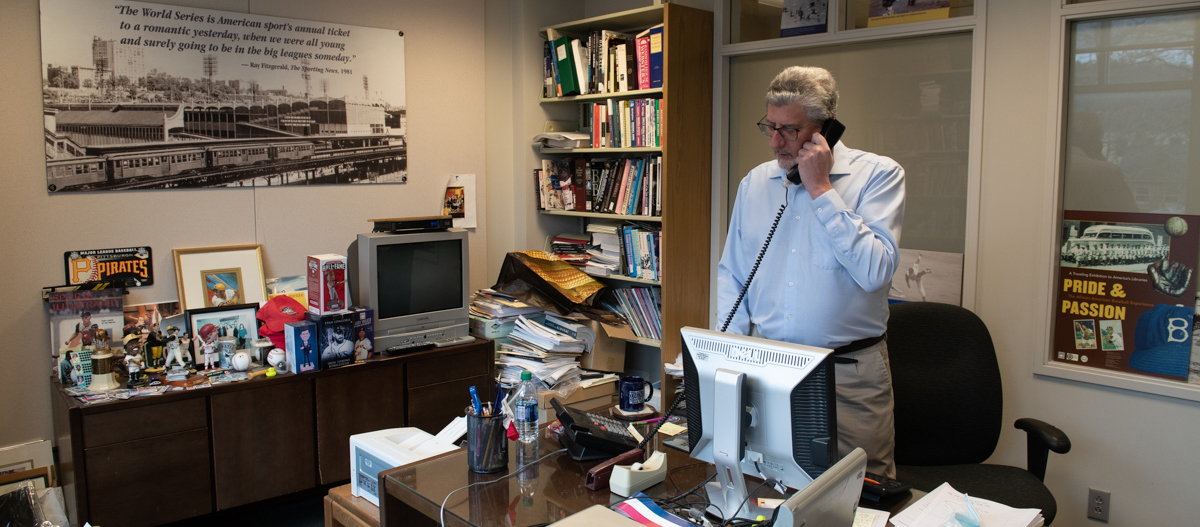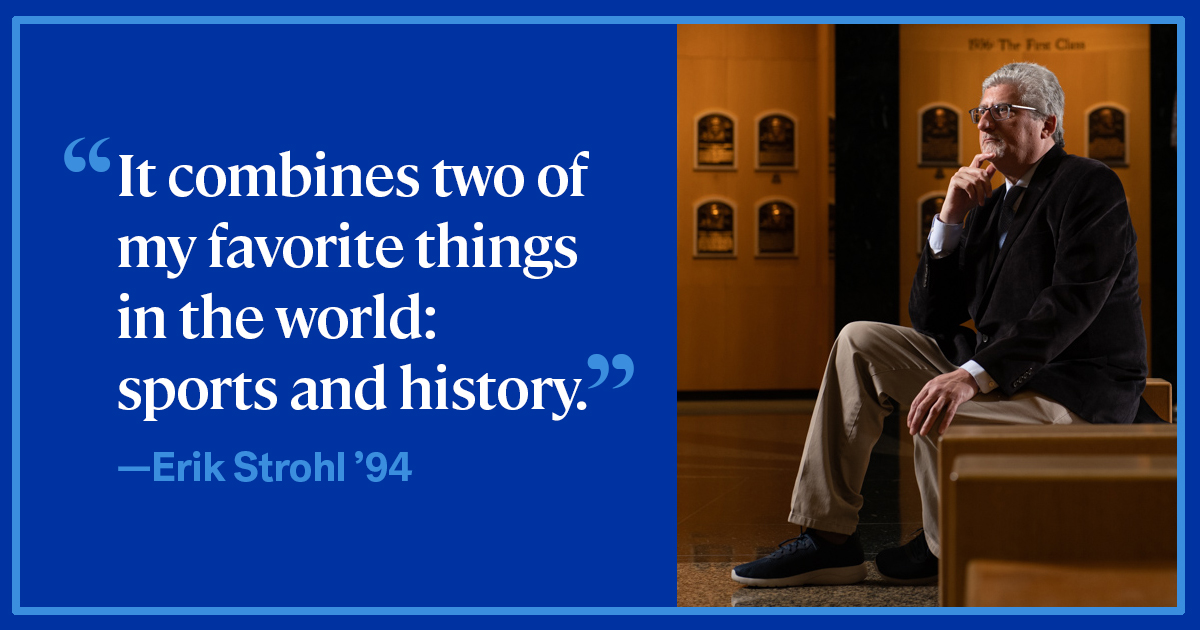
The Master Curator of Our National Pastime
As chief curator of the National Baseball Hall of Fame and Museum, Erik Strohl ’94 brings the game’s storied past back to life for new generations of fans.
By Jeff Csatari
Photographs by Kriston Jae Bethel
Put yourself in Erik Strohl’s sneakers. You’ve been a sports junkie since you were a kid playing street hockey and sandlot baseball in Coplay, Pennsylvania. The Pittsburgh Pirates have been your team since you and your older brother watched them win it all in 1979. You’ve flipped your share of baseball cards (cards you still own) and organized your favorite players by batting averages. The stats and stuff of baseball history are in your marrow.
Now, many years later, you’re sitting on the front porch of Hank Aaron’s boyhood home in Mobile, Alabama, listening to “Hammerin’ Hank” himself tell stories of growing up “Down the Bay.” Aaron tells you he hit bottlecaps with a stick right there in the front yard because he couldn’t afford a bat and ball. He reminisces about playing baseball at Carver Park, the first African American park in Mobile, and being signed at age 17 by the Indianapolis Clowns, the Negro Leagues’ barnstorming version of the Harlem Globetrotters.
“Henry told me about the day he left home [for Indianapolis], waiting at the train station with a bag of sandwiches his mother packed for him,” recalls Strohl. “He said the train ride was the first time in his life he was around white people.”
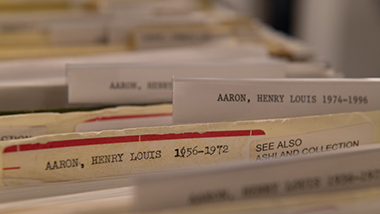
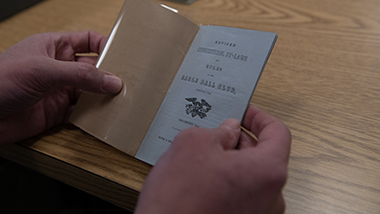
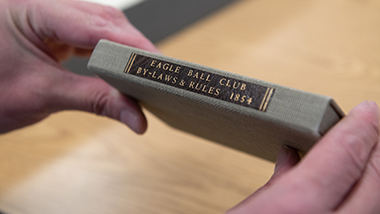
Above: In the HOF archives, files document nearly every one of the 22,500 men who played Major League Baseball since 1871, including the Negro Leagues players.
Among the artifacts is an 1854 volume of bylaws and rules of the Eagle Ball Club, one of the earliest ball clubs, organized in 1840.
Strohl is the vice president for exhibitions and collections at the National Baseball Hall of Fame and Museum (HOF) in Cooperstown, New York. Over the course of trips to Mobile and Aaron’s home in Atlanta, Strohl spent many hours with the legendary Braves slugger whose historic 715th career home run topped Babe Ruth’s record on April 8, 1974. Aaron invited Strohl to his boyhood and Atlanta homes to inventory personal artifacts Aaron donated to Cooperstown. The exhibit is one of only two telling the story of a single player at the museum. The other honors Yankees legend Babe Ruth. “We’re talking about two men who transcended the sport to become cultural icons,” says Strohl. “They were awesome on the field, but what they did off the field was just as important.”
Strohl points out a case displaying the Presidential Medal of Freedom, the nation’s highest civilian honor, that President George W. Bush awarded Aaron in 2002 for his work on advancing civil rights and helping children develop their potential through the Chasing the Dream Foundation with his wife Billye. The “Chasing the Dream” exhibit is rich with personal items donated by Aaron, including the bat and ball he used to hit homer 714, which tied Babe Ruth’s record. And displayed on a mannequin next to his Braves locker is the uniform Aaron wore when he hit the record-breaking #715.
“When I show
an inductee the place where their likeness will be enshrined for all posterity,
wow, you can see in their eyes, it finally hits them.” —Erik Strohl ’94
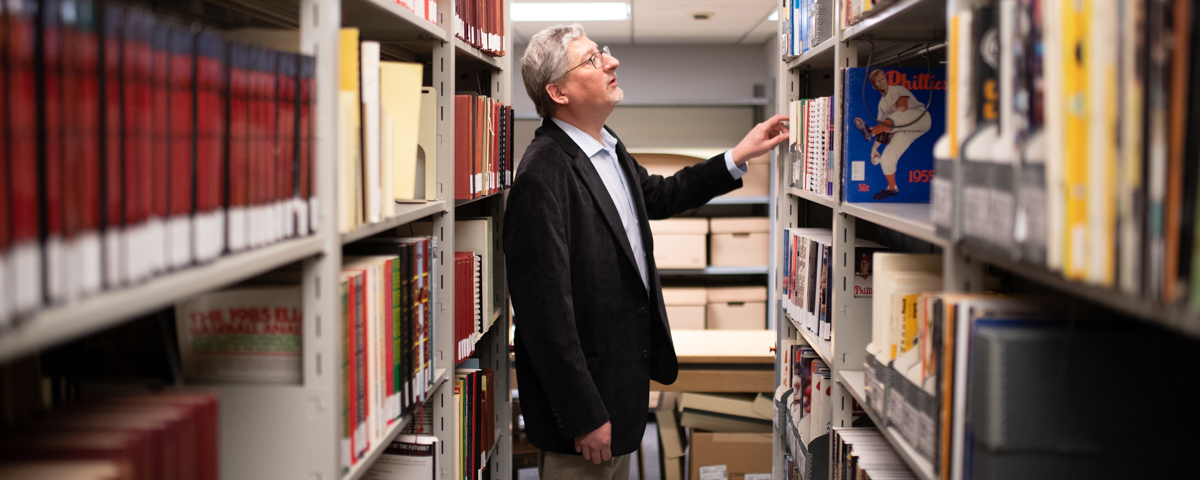
The library stacks
Chasing His Own Dream
Strohl, 49, who is in his 24th year at the HOF, studied history at Moravian College and spent a semester at the Centre for Medieval and Renaissance Studies at Oxford University. Upon graduation, Strohl didn’t know what he wanted to do with his life, so he took a job as a manager of a Suncoast video store at the Lehigh Valley Mall in Whitehall, Pennsylvania. But it seems museum work was always in his DNA.
“As a kid I loved history, loved museums,” he says. “Every summer, my family would travel to museums. My parents had to drag me out; I wanted to read every word.”
Strohl’s father, William (Moravian Class of 1961), was a middle school guidance counselor and a collector of Americana and antiques. His nana’s house was “full of scavenged treasures.” His mother, Beverly Tisdale ’60, was an English professor at Cedar Crest College, while his stepfather, John Tisdale, taught psychology and religion there (Strohl’s stepsister Deborah Tisdale Cozen ’80 is a Moravian grad, and stepsister Suzanne Kompass is artist in residence and master vocal teacher at Moravian). The son of teachers, Strohl says he learned early on that he didn’t want to go into teaching. But while he may not stand in front of a class, his vocation is all about educating young and old about the game they love.
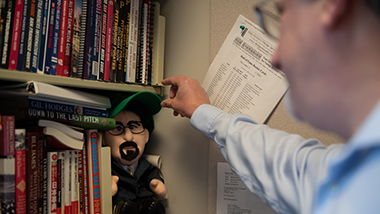
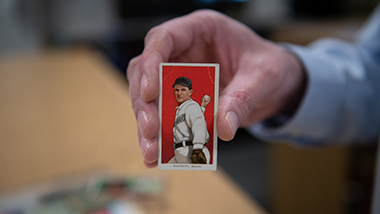
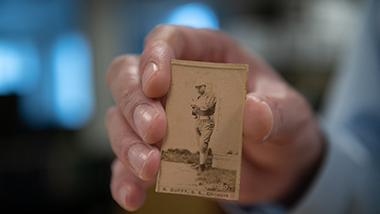
Rare baseball cards in the HOF collection include an N172 from 1888 showing Hall of Famer Hugh Duffy
and a T206 from 1909–11 showing Hall of Fame pitcher Joe McGinnity; these came in packs of Old Judge cigarettes.
In 1997, Strohl moved to Cooperstown to attend the Cooperstown Graduate Program, one of the nation’s oldest museum studies programs. In March of 1998, he started an internship at the Baseball Hall of Fame. One of his early tasks was creating an inventory of the hall’s 300 original baseball illustrations and cartoons that were used in newspapers and magazines, a project that became his master’s thesis, “Drawn to the Game.”
Even before he graduated, Strohl was offered a full-time position at the HOF. And he never left. How could he? “It combines two of my favorite things in the world,” he says: “sports and history.” Strohl’s first exhibit chronicled the events of the Great American Home Run Chase in 1998 when Ken Griffey Jr., Sammy Sosa, and Mark McGwire raced to top Roger Maris’s single-season home run record of 61, set in 1961. “The chase brought fans back to baseball after the 1994 strike,” recalls Strohl. “Of course, I have mixed feelings in hindsight.”
Since then, Strohl has been involved with every major exhibit created at the museum. In his current role, he manages four departments, including the museum and library collections. In all, the museum contains roughly 35,000 three-dimensional artifacts—bats, balls, uniforms, cleats, gloves, and trophies, to name just a few categories—15,000 hours of film and audio, including the first known recording of “Take Me Out to the Ball Game,” made on an Edison wax cylinder in 1908, and 300,000 baseball cards, two of which are the most celebrated of baseball collectibles, the Honus Wagner T206 cards. The library itself holds more than 3 million items.
The hall’s curatorial/exhibits/library staff has grown, too, under Strohl’s leadership. Today he manages 20 full-time staffers who maintain and organize the collection and design and produce updates for the hall and traveling exhibits. “These days, I’m more of the conductor than part of the orchestra,” Strohl says. A new exhibit can take up to two years to plan, design, and build before fans can see it.
“Erik’s knowledge is vast, and not just about the bats and balls of baseball history,
but how baseball shaped American culture and American culture shaped baseball.”
—Susan MacKay, HOF director of collections
Erik Strohl’s office at the National Baseball Hall of Fame and Museum.
The Vault
Underneath the exhibit space in the basement of the hall, Strohl swipes a key card to open the door of a large climate-controlled storage bunker housing artifacts not open to the public. He hands a visitor a pair of gloves and dons a pair himself to keep the oils of human hands from deteriorating the delicate items inside. On one wall are shelves of archival cardboard boxes holding uniforms of famous players: Berra, Mays, Ruth. The list goes on. Strohl shows an Olympic jersey worn by one of the six Jewish American players who went to the Olympic Games in Berlin in 1936 when baseball was a demonstration sport. He picks up a baseball signed by Ruth, Giants pitcher Christy Mathewson, baseball’s first commissioner Kenesaw Mountain Landis, President Warren Harding, and Vice President Calvin Coolidge.
“Check this out,” he says. “Moe Berg’s catcher’s mask.” Strohl tells a story behind every item he pulls. Then he hands his guest one of Honus Wagner’s dark brown bats with a wide body and thick handle that tapers ever so slightly to the knob. “Compare that to this one,” he says, handing over a modern-day bat, which happens to be three-time MVP and eight-time Silver Slugger Mike Trout’s. The bottle bat is far heavier, more than 45 ounces. Strohl grabs back the 100-year-old potato masher and assumes a baseball stance, looking like a very tall 10-year-old with a sparkle in his eyes. “Old-time players would choke way up, just like this. Can you imagine swinging a bat that heavy?”
Strohl opens a large metal cabinet filled with more bats, each from a famous player: Stan Musial, Ted Williams, Lou Gehrig, Mike Schmidt . . . It seems like you’re shaking hands with the heroes of the game, but somehow it feels even better.
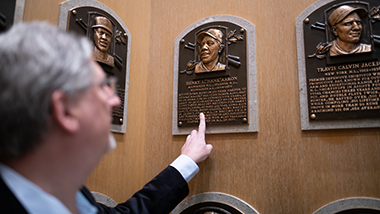
Henry "Hank" Aaron
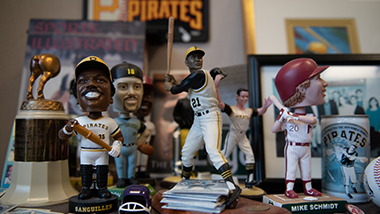
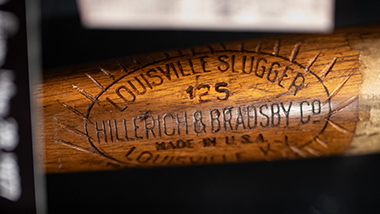
Babe Ruth’s 1927 Louisville Slugger
Sacred Halls
The “fun part” of museum work, says Strohl, is sifting through the artifacts and choosing those that will tell the exhibit’s story best. “We start with an empty slate, brainstorm a concept, come up with two or three thesis points, and make sure every visual we show comes back to those points.”
For one of the most challenging exhibits Strohl and his staff have completed, “Picturing America’s Pastime,” the curators culled the collection’s 300,000 photographs into an exhibit of 51. “We couldn’t decide between two images, so we chose 51,” he says. “They’re not the most famous baseball moments, but 51 images that taken as a whole give you the best understanding of the breadth and depth of our entire photo archive.”
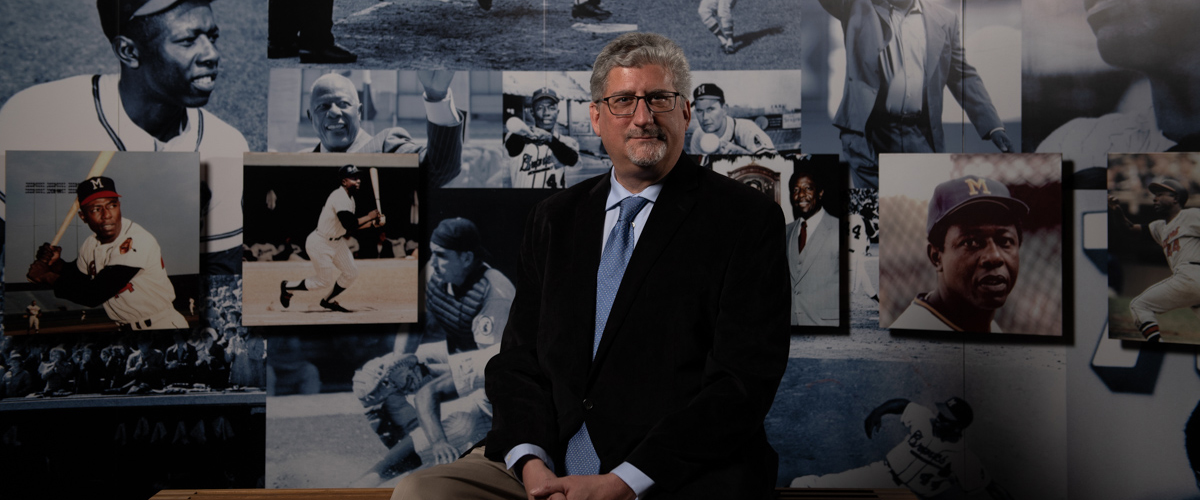
The Hank Aaron exhibit is one of only two telling the story of a single player at the museum.
Other favorite gems in the museum:
- Babe Ruth’s notched bat. The Bambino used a penknife to carve 28 notches round the Louisville Slugger logo above the bat’s handle, one for each home run he hit with this bat during the famous ’27 season before it broke.
- The “Ideals and Injustices” exhibit, which chronicles the Black baseball experience from the mid-19th century to the heyday of the Negro Leagues to the integration of Major League Baseball when Jackie Robinson broke the major league color barrier in 1947.
- The Top Ten Tower, an interactive touchscreen fans can use to search historic milestones and compare player statistics in the museum’s “One for the Books” exhibit.
- A room with green screen technology that allows visitors to superimpose themselves on a series of historical baseball cards they can email to themselves and print out at home. “How people consume culture has changed,” says Strohl, “so museums have to learn to adapt. A challenge of all museums is trying to capture the interest of young people through technology.”
“Jeter came as advertised. He checks every box: athletic, smart, friendly, morally upstanding,
and he was genuinely into the tour. It’s hard to impress these players, but
like every Hall of Famer, hand him a Babe Ruth bat, and he’s like, ‘Oh, my God!’”
—Erik Strohl ’94
One of Strohl’s most enjoyable tasks as chief curator is also one of his most stressful. Each year prior to the HOF induction ceremony, Strohl takes new inductees and their families on a private tour of the museum and vault collection. It involves hours of research work with his staff to learn about the players’ backgrounds from Little League play through the majors, who their heroes and famous opponents were. “We’re followed around by an MLB Network TV crew, and I can’t use a script as a cheat sheet, so if I get a fact wrong there are no do-overs.”
The most recent Hall of Famer he chaperoned was Derek Jeter, a member of the HOF class of 2020 that included Marvin Miller, Ted Simmons, and Larry Walker. (The ceremony was postponed until 2021 due to COVID-19, and no candidates were elected last year.)
“Jeter came as advertised,” Strohl said. “He checks every box: athletic, smart, friendly, morally up-standing, and he was genuinely into the tour. It’s hard to impress these players, but like every Hall of Famer, hand him a Babe Ruth bat and he’s like, ‘Oh, my God!’”
Most inductees have never been to the Hall of Fame before, so Strohl says their reaction is like any visitor’s: “overwhelmed by what’s within our walls.”
At the end of each tour, Strohl ushers them into the cathedral-like plaque gallery, past the bronze reliefs of Cobb, Ruth, Mathewson, Gehrig, and other greats.
“When I show an inductee the place where their likeness will be enshrined for all posterity, wow, you can see in their eyes, it finally hits them.”
Jeff Csatari is executive editor of Galvanized Brands (the media company founded by David Zinczenko ’91) and an adjunct professor of journalism.

